Airport type Military Code NKX | Elevation AMSL 477 ft / 145 m Elevation 146 m | |
In use 18 July 1917 – 30 October 19201929 – present Commander Col. Jason G. Woodworth Operator | ||
U s marine corps air station miramar air show 2015 day 2
Marine Corps Air Station Miramar (MCAS Miramar) (IATA: NKX, ICAO: KNKX, FAA LID: NKX), formerly Naval Auxiliary Air Station (NAAS) Miramar and Naval Air Station (NAS) Miramar is a United States Marine Corps installation that is home to the 3rd Marine Aircraft Wing, which is the aviation element of the 1st Marine Expeditionary Force. It is located in Miramar, San Diego, California, about 10 miles (16 km) north of Downtown San Diego.
Contents
- U s marine corps air station miramar air show 2015 day 2
- Tenant commands
- Geography
- History
- 19181941
- World War II
- Naval Air Station
- Recent history
- Noise
- Crashes
- Miramar National Cemetery
- Attractions
- References
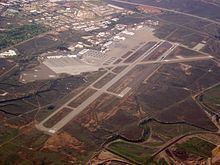
The airfield is named Mitscher Field after Admiral M.A. Mitscher who was the commander of Task Force 58 during World War II. The air station is the former location of Pacific Fleet fighter and Airborne Early Warning and Control aircraft (F-4 Phantom II, F-14 Tomcat, E-2 Hawkeye) and is best known as the former location of the United States Navy Fighter Weapons School (NFWS), its TOPGUN training program and the movie of the same name. In 1996, NFWS was relocated to Naval Air Station Fallon in western Nevada and merged into the Naval Strike and Air Warfare Center (NSAWC). During the heyday of TOPGUN at NAS Miramar, the station was nicknamed "Fightertown USA".
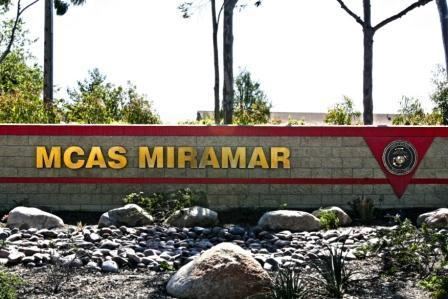
Tenant commands
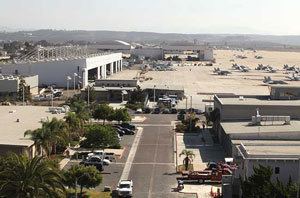
Geography
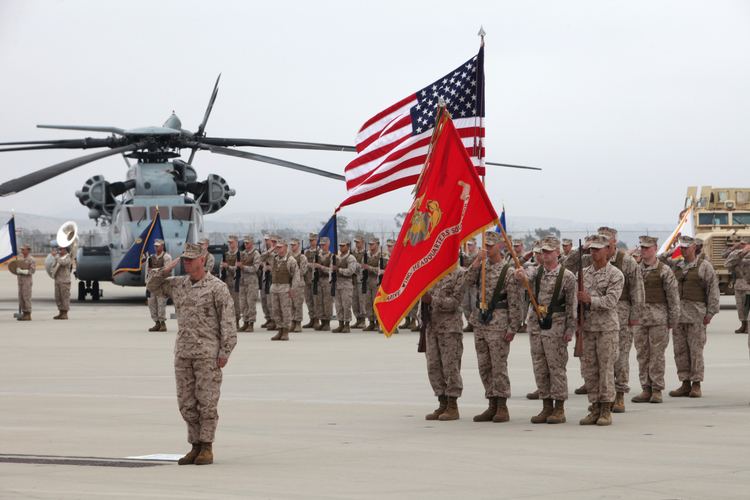
The base contains 23,116 acres (93.55 km2). It is bisected by Kearny Villa Road and Interstate 15. The area east of Kearny Villa Road, called "East Miramar", is undeveloped and is used for military training.
History
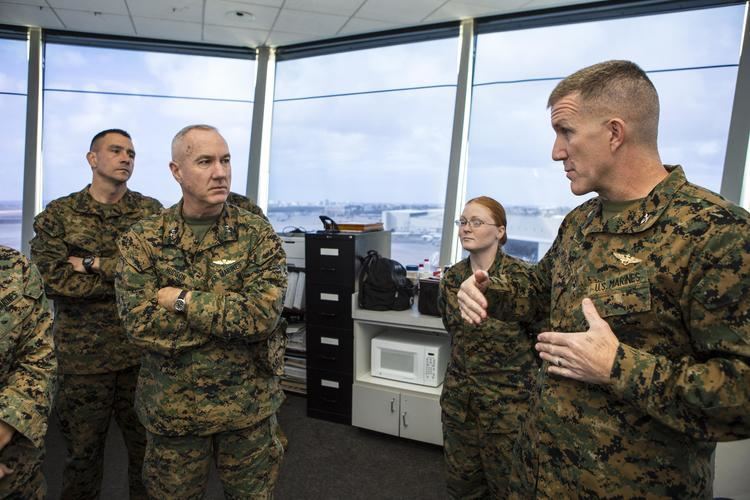
Kumeyaay Native Americans were the first inhabitants in the vicinity of the base. Spain claimed the San Diego area in 1542 and colonized it beginning in 1769. In 1846 the crown issued a land grant that included the area of the current base to Don Santiago Argüello. After the American Civil War, the land was divided and sold to people such as Edward Scripps, a newspaper publisher from the eastern United States, who developed a ranch on the site. It was Scripps who named the area Miramar, meaning "view of the sea". The land was predominantly used for grazing and farming into the early 20th century.
1918–1941
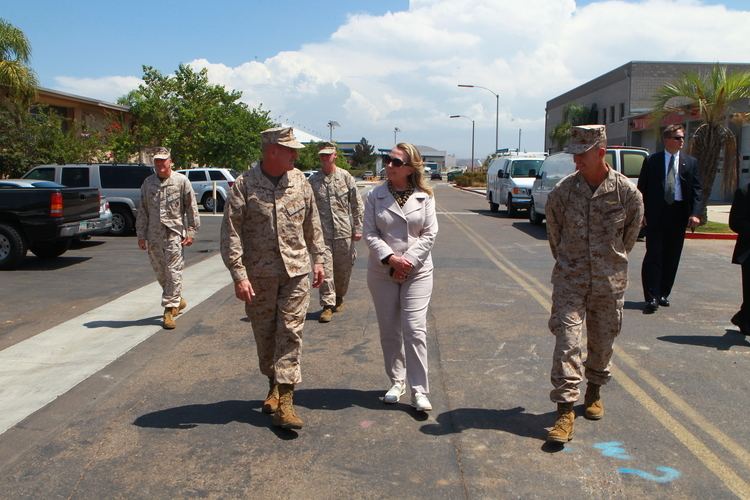
During World War I, the U.S. Army acquired 12,721 acres (5,148 ha) of land in the Miramar Ranch area, on a mesa north of San Diego. Camp Kearny was opened on 18 January 1917 and was named after Stephen W. Kearny, who was commander of the Army of the West during the Mexican-American War. The base was primarily used to train infantrymen on their way to the battlefields of Europe. During World War I an airstrip was never built on the property, although Army and Navy aircraft from Naval Air Station North Island did land on the parade deck. Following the Armistice, the base was used to demobilize servicemen and was closed on 20 October 1920. More than 1,200 buildings were demolished when the camp closed.
Charles Lindbergh's Spirit of St. Louis airplane was built in nearby San Diego. Lindbergh used the abandoned Camp Kearny parade field to practice landings and take-offs before making his historic solo flight across the Atlantic Ocean.
During the 1930s, the Navy briefly used the air base for helium dirigibles. In 1932 a mooring mast and hangar were built at the camp for the dirigibles, but when the program was abandoned, the base was quiet again.
World War II
By the time World War II began, Miramar was already undergoing a “precautionary” renovation. Camp Holcomb (later renamed Camp Elliott) was built on part of old Camp Kearny, to be used for Marine artillery and machine gun training. Camp Elliott became home to Fleet Marine Force Training Center, West Coast and the 2nd Marine Division, charged with defending the California coast. Runways were constructed in 1940, and the 1st Marine Air Wing arrived on December 21 of that year. The Navy commissioned Naval Auxiliary Air Station (NAAS) Camp Kearny in February 1943, specifically to train crews for the Consolidated PB4Y-2 Privateer, which was built less than 10 miles (16 km) away in San Diego. A month later, the Marines established Marine Corps Air Depot Camp Kearny, later renamed Marine Corps Air Depot Miramar, to avoid confusion with the Navy facility.
The big Privateers proved too heavy for the asphalt concrete runway the Army had installed in 1936 and the longer runways built in 1940, so the Navy added two concrete runways in 1943.
During the 1940s, both the Navy and the Marine Corps occupied Miramar. East Miramar (Camp Elliott) was used to train Marine artillery and armored personnel, while Navy and Marine Corps pilots trained on the western side. The bases were combined and designated Marine Corps Air Station Miramar in 1946.
Naval Air Station
In 1947, the Marines moved to MCAS El Toro in Orange County, California, and Miramar was redesignated as NAAS Miramar (Naval Auxiliary Air Station Miramar). It became NAS Miramar (Naval Air Station Miramar) on 1 March 1952. In 1954, the Navy offered NAS Miramar to San Diego for $1 and the city considered using the base to relocate its airport. But it was deemed at the time to be too far away from most residents and the offer was declined.
Only the western half of Miramar’s facilities were put to use, and the old station literally began to deteriorate, with many buildings sold as scrap. Miramar found new life as a Navy Master Jet Station in the 1950s. The eastern half, former Camp Elliot, was used by the United States Air Force for Project Orion (having been transferred temporarily), and later by NASA; It was the site of several launches. The base really came into its own during the Vietnam War. The Navy needed a school to train pilots in dog-fighting and in fleet air defense. In 1969 the United States Navy Fighter Weapons School was established organizationally as part of VF-121, which was then the F-4 Phantom Fleet Replacement Aviation Maintenance Personnel (FRAMP), which trained the maintainers who joined the fleet as qualified "Phantom Phixer's"
In October 1972, Miramar welcomed the F-14 Tomcat and fighter squadron VF-124, a former Fleet Replacement Squadron (FRS) was tasked with the mission to train new Tomcat crews. Formerly, VF-124 had been training pilots in the F-8 Crusader. That task was handed over to Light Photographic Squadron 63 (VFP-63) that then became "Crusader College" The first two operational Tomcat squadrons, VF-1 known as the "Wolfpack" and VF-2 known as the "Bounty Hunters," trained here before deploying aboard USS Enterprise (CVN-65) in 1974.
Recent history
In 1993, the Base Realignment and Closure Commission recommended that Marine Corps Air Station El Toro and Marine Corps Air Station Tustin be closed down and that NAS Miramar be transferred to the Marine Corps. BRAC also recommended that all Navy Pacific Fleet F-14 aircraft and squadrons (with the exception of those assigned to Carrier Air Wing 5 in Japan) and Pacific Fleet F-14 training be consolidated with the Atlantic Fleet and be relocated to NAS Oceana, Virginia. BRAC recommended that Pacific Fleet E-2C training be consolidated with Atlantic Fleet E-2C training at Naval Station Norfolk, Virginia, that all Pacific Fleet E-2C aircraft and squadrons (with the exception of those assigned to Carrier Air Wing 5 in Japan) be relocated to NAS Point Mugu, California and that the Naval Fighter Weapons School (TOPGUN) and Navy Reserve adversary squadron VFC-13 be relocated to NAS Fallon, Nevada.
In 1999, MCAS El Toro and MCAS Tustin were closed and the 3rd Marine Aircraft Wing returned to Miramar when it officially became Marine Corps Air Station Miramar. On October 1, 1997, Colonel Thomas A. Caughlan became the first Marine commanding officer of MCAS Miramar since World War II. Caughlan was also the last commanding officer of MCAS Tustin.
In 2005, the BRAC Commission directed instructor pilots and support personnel from Miramar to Eglin AFB in Florida, sufficient to stand up the Marine Corps' portion of the F-35 Lightning II Joint Strike Fighter Program (JSF) Training Site. This will lead to an eventual phasing out of Fighter Pilot training at Miramar by 2015 as the F-18s are retired.
In 2006, the San Diego County Proposition A proposed obtaining 3000 acres (12 km²) at MCAS Miramar to develop a commercial airport. The proposition was defeated 62 percent opposed to 38 percent in favor.
Noise
To lessen the noise impact to the community, MCAS Miramar has made adjustments to their operations over the years, including the use of hush-houses, limitations on engine run-ups, and modification to flight plans.
Crashes
There have been a number of aviation accidents:
Miramar National Cemetery
On 30 January 2010, the Department of Veterans Affairs dedicated a new National Cemetery at the northwest corner of MCAS Miramar. The cemetery is an extension of Fort Rosecrans National Cemetery and when complete will accommodate approximately 235,000 deceased veterans and spouses.
